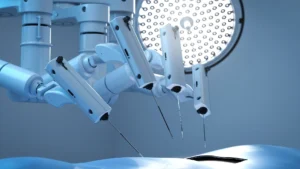The field of surgery has undergone remarkable transformations over the past few decades, driven by technological innovation and the quest for minimally invasive techniques. Among the most groundbreaking advancements is robotic surgery, a technique that uses robotic systems to assist surgeons in performing complex procedures with enhanced precision, control, and minimal invasiveness.
India, with its rapidly advancing medical infrastructure, has embraced this technology enthusiastically. The country is not only offering robotic surgeries at par with global standards but also making it accessible to a broader demographic due to relatively lower costs compared to Western countries. This blog explores the evolution, current status, benefits, challenges, and future of robotic surgery in India
.
What is Robotic Surgery?
Robotic surgery, also known as robot-assisted surgery, involves the use of robotic systems controlled by surgeons to perform surgical procedures. Unlike traditional surgery, which requires large incisions and manual tools, robotic surgery utilizes:
- Miniaturized instruments
- High-definition 3D cameras
- Advanced robotic arms
The most widely used system is the da Vinci Surgical System, which allows surgeons to operate with enhanced dexterity, precision, and visualization. The surgeon remains in control throughout, manipulating the robotic arms from a console while the robotic system translates the surgeon’s movements in real-time.
History and Adoption of Robotic Surgery in India
Robotic surgeon made its entry into India in the early 2000s. The first installation of the da Vinci Surgical System in India occurred in 2002 at All India Institute of Medical Sciences (AIIMS), Delhi.
Since then, the growth has been exponential:
- As of 2025, India has over 130 robotic surgical systems installed across major hospitals.
- Robotic surgeries are now being performed in urology, gynecology, cardiothoracic surgery, gastrointestinal surgery, oncology, and ENT.
Key Applications of Robotic Surgery in India
- Urology
- Prostatectomy (Prostate cancer removal)
- Kidney tumor removal (Partial nephrectomy)
- Robotic-assisted urological procedures dominate the field due to the need for precision in confined pelvic areas.
- Gynecology
- Hysterectomy
- Myomectomy (removal of fibroids)
- Endometriosis treatment
- Robotic surgery is preferred for its minimal invasiveness, especially for women with complex pelvic anatomy or prior surgeries.
- Oncology
- Colorectal cancer
- Esophageal and gastric cancer
- Head and neck tumors
- Precision and complete tumor resection with minimal tissue damage are critical in oncology, making robotic assistance valuable.
- General Surgery
- Gallbladder removal
- Hernia repairs
- Bariatric surgery (obesity surgery)
- Cardiac Surgery
- Minimally invasive coronary artery bypass grafting (CABG)
- Valve repairs
- While still evolving, robotic cardiac surgery is gaining traction in India.
Benefits of Robotic Surgery
- Greater Precision-Robotic arms can make microscopic movements that eliminate human tremors, allowing for incredibly fine surgical work.
- Enhanced Visualization-3D high-definition cameras provide magnified views of the surgical field, improving the surgeon’s ability to distinguish tissues and vessels.
- Minimally Invasive-Smaller incisions mean:
- Less blood loss
- Reduced pain
- Minimal scarring
- Shorter hospital stays
- Faster Recovery-Most patients return to daily activities faster than those undergoing open surgery.
- Reduced Risk of Infection-Smaller wounds reduce the chance of postoperative infection, especially in immunocompromised or elderly patients.

Challenges in the Indian Context
- High Cost of Installation-A robotic system like the da Vinci Xi can cost between ₹15 to ₹25 crore, making it a major capital expenditure for hospitals.
- Cost to Patients-Though cheaper than in Western countries, robotic surgeries in India still cost significantly more than conventional or laparoscopic procedures:
- Robotic prostatectomy: ₹2.5–₹5 lakh
- Robotic hysterectomy: ₹2–₹4 lakh
This can be unaffordable for a large segment of the population.
- Lack of Trained Surgeons-Robotic surgeon requires extensive training and certification. Currently, only a limited number of surgeons in India are proficient in these systems.
- Limited Access in Tier-2 and Tier-3 Cities-While metros like Delhi, Mumbai, Bengaluru, and Chennai offer robotic surgery widely, smaller towns lack the infrastructure and expertise.
- Insurance Coverage-Most insurance providers still do not cover the full cost of robotic procedures, deterring many from opting for them.
Major Hospitals Offering Robotic Surgery in India
Several top-tier hospitals across India have adopted robotic surgery and are offering world-class care:
- AIIMS, Delhi-One of the first institutions to adopt robotic surgery; offers it across urology, GI surgery, and oncology.
- Medanta – The Medicity, Gurugram-Led by renowned cardiac surgeon Dr. Naresh Trehan, Medanta has one of the largest robotic surgery programs in India.
- Apollo Hospitals-With over 70 hospitals, Apollo has robotic surgical capabilities in cities like Chennai, Hyderabad, and Bengaluru.
- Fortis Healthcare-Offers robotic surgeries across multiple specialties, especially urology and oncology.
- Manipal Hospitals-Robotic procedures available in Bengaluru, Delhi, and Jaipur locations.
- Tata Memorial Hospital, Mumbai-India’s leading cancer center uses robotic surgeon extensively in head and neck, GI, and gynecologic cancers.


Robotic Surgery vs. Laparoscopic Surgery
| Feature | Robotic Surgery | Laparoscopic Surgery |
| Precision | Superior due to robotic arms | Good, but limited by human dexterity |
| Vision | 3D High-definition | 2D camera |
| Ergonomics | Surgeon sits comfortably at console | Surgeon stands at the operating table |
| Cost | Higher | Moderate |
| Learning Curve | Steeper | Less complex |
Cost Comparison of Robotic Surgeries in India (2025)
| Procedure | Robotic Surgery Cost | Traditional Surgery Cost |
| Prostatectomy | ₹2.5–₹5 lakh | ₹1–₹2.5 lakh |
| Hysterectomy | ₹2–₹4 lakh | ₹1–₹2 lakh |
| Partial Nephrectomy | ₹3–₹5 lakh | ₹1.5–₹3 lakh |
| Colorectal Cancer Surgery | ₹3–₹6 lakh | ₹2–₹4 lakh |
| Bariatric Surgery | ₹3.5–₹6 lakh | ₹2–₹4 lakh |
Future of Robotic Surgery in India
- More Affordable Systems-Companies like Medtronic, CMR Surgical (Versius), and India’s own SS Innovations are developing cost-effective robotic platforms, which could drastically reduce the cost barrier.
- Government Support-Schemes like Ayushman Bharat may eventually cover advanced surgical options, increasing access for economically weaker sections.
- Expansion into Smaller Cities-With costs reducing and training expanding, tier-2 and tier-3 cities may soon have access to robotic surgery.
- Integration with AI and Machine Learning-Future robotic systems may utilize AI to assist in decision-making, automate parts of surgery, and enhance real-time feedback.
- Telesurgery-India, being a hub for telemedicine, may eventually adopt telesurgery, where expert surgeons operate remotely using robotic systems — particularly useful in rural or under-served areas.
Conclusion
Robotic surgeon represents a significant leap forward in medical science, offering unmatched precision, reduced trauma, and faster recovery. In India, the technology is already transforming lives, making surgeries safer and more effective. While the cost remains a challenge, the landscape is rapidly evolving with indigenous innovations, expanded training, and increasing awareness.
As the technology becomes more accessible, India stands poised to not only democratize robotic surgeon for its population but also emerge as a global hub for advanced surgical care. With continued investment, training, and innovation, the future of robotic operation in India is undeniably bright.